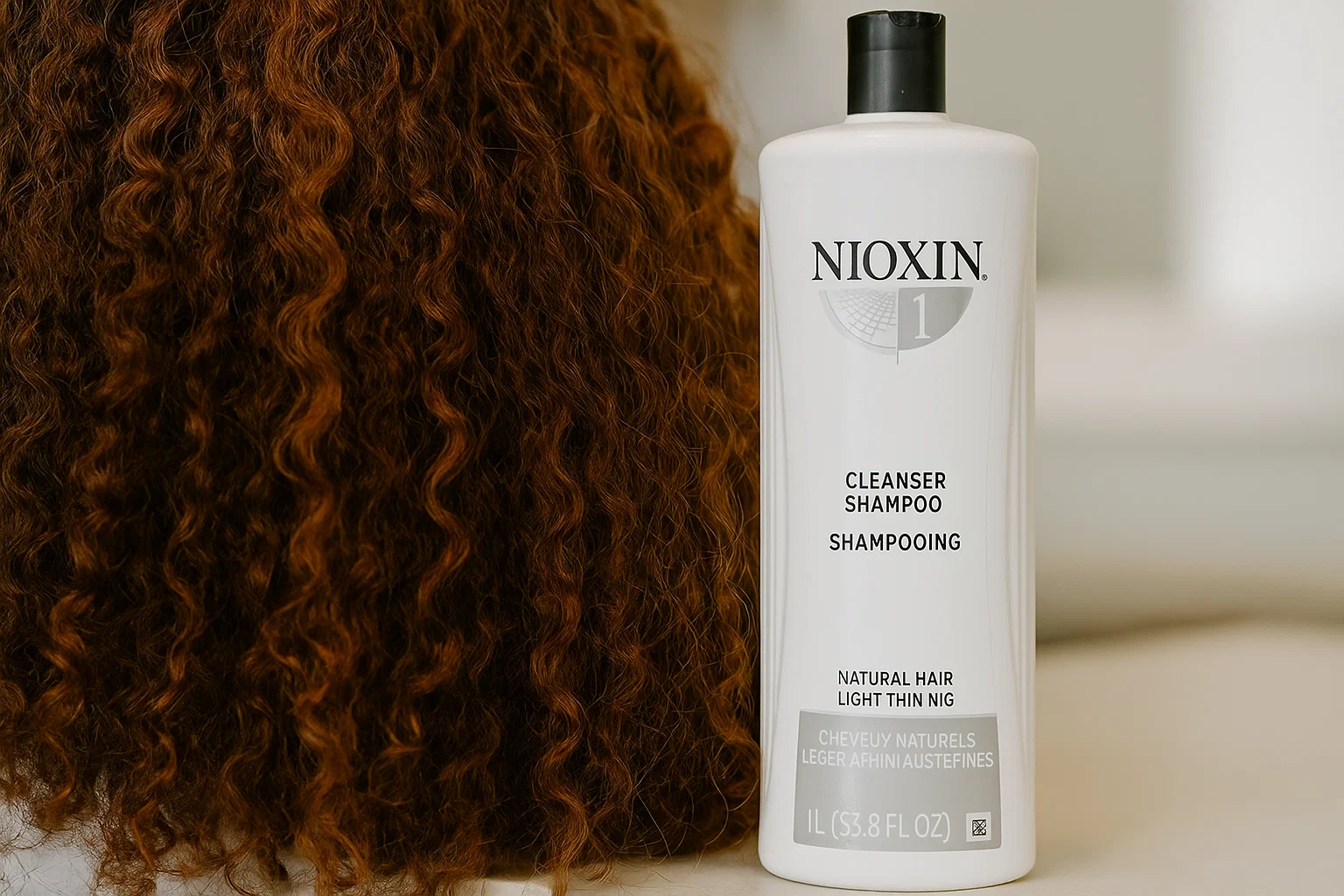Is Nioxin Shampoo Good for Curly Hair? An Honest Expert Breakdown
 If you’ve ever battled thinning hair or scalp buildup, there’s a good chance someone recommended Nioxin. Maybe a stylist said, “It’ll help your scalp breathe again.” Or maybe you saw that sleek silver bottle promising thicker, fuller hair and wondered could this actually help my curls?
If you’ve ever battled thinning hair or scalp buildup, there’s a good chance someone recommended Nioxin. Maybe a stylist said, “It’ll help your scalp breathe again.” Or maybe you saw that sleek silver bottle promising thicker, fuller hair and wondered could this actually help my curls?
I’ve used, studied, and analyzed Nioxin for years both on my own clients and in lab-based ingredient testing. It’s one of those products that works beautifully for some and terribly for others. And for curly hair? The answer isn’t black or white. Let’s dig in gently but deeply.
What Nioxin Was Originally Made For
Before deciding if Nioxin is good for curly hair, you need to understand what it was built to do.
Nioxin was designed in the late 1980s by Eva Graham not as a “curly hair” product but as a scalp treatment for thinning hair. Its main goal: to stimulate the scalp, remove buildup, and strengthen hair follicles.
The system works like a 3-step routine shampoo (Cleanser), conditioner (Scalp Therapy), and scalp treatment (leave-in). There are six versions, each targeting a specific hair type and level of thinning.
Now here’s the catch: the ingredients in Nioxin are more stimulating than nourishing. Think of them as gym trainers for your follicles not soft blankets for your curls.
The Reality About Curly Hair Needs
Curly hair behaves differently from straight hair at every level.
It’s naturally drier, more porous, and often lacks uniform moisture from root to tip. Curly strands also have more raised cuticles, which means they lose hydration quickly.
Most curl types especially 3A to 4C thrive on moisture, oils, and gentle cleansing, not heavy exfoliation or menthol-based stimulation.
So when you bring a scalp-stimulating shampoo like Nioxin into a curl routine, things can go both ways depending on what your hair truly needs.
Ingredient Breakdown: What’s Inside Nioxin
Let’s pull out the microscope. Here’s what makes Nioxin tick and how those ingredients interact with curly hair.
1. Niacinamide (Vitamin B3)
A hero for scalp health. Studies show it improves barrier function and microcirculation, meaning it helps follicles receive nutrients better (PubMed, 2018).
✅ Good for: Promoting growth and reducing inflammation
⚠️ For curls: Great if your scalp is oily or flaky but not a moisturizer
2. Peppermint Oil (Menthol)
Creates that icy, tingling feeling. Research shows menthol increases blood flow to the scalp (Journal of Toxicological Research, 2014).
✅ Good for: Stimulating follicles
⚠️ For curls: Can be drying or irritating, especially for sensitive scalps
3. Sodium Lauryl Sulfate / Sodium Laureth Sulfate (depending on version)
These are strong surfactants powerful cleansers that strip away oil and buildup.
✅ Good for: Deep scalp cleansing
⚠️ For curls: Too harsh for frequent use they remove natural oils curls desperately need
4. Panthenol (Pro-Vitamin B5)
Balances the drying effects of surfactants by coating strands with a thin moisture layer.
✅ Good for: Shine, softness
⚠️ For curls: Helpful but can’t fully counteract the dryness from sulfates
5. Caffeine & Green Tea Extract
These are part of Nioxin’s “antioxidant complex.” Studies suggest caffeine may extend the growth phase (anagen) of hair follicles (International Journal of Dermatology, 2007).
✅ Good for: Supporting hair growth cycles
⚠️ For curls: No harm, but limited direct benefit for curl pattern or frizz
What Research Says
Dermatological reviews of Nioxin systems have shown up to 71% of users experience reduced hair breakage and improved density perception after consistent use for three months.
But and this is important most participants had fine, straight, or chemically thinned hair, not coily or curly textures.
A 2020 consumer survey published by the Journal of Cosmetic Dermatology also noted that users with textured or curly hair often reported dryness and scalp tightness after prolonged use.
So while Nioxin scores high on scalp cleansing and follicle stimulation, it scores low on moisture retention the lifeline of curly hair.
Real-World Salon Observations
I’ve seen this shampoo do wonders for clients dealing with shedding or post-partum thinning especially those with looser curls (2C–3A). Their scalp feels fresher, and new baby hairs start showing up after consistent use.
But when my tight-coil clients (3C–4C) tried it? Their curls lost elasticity fast. The hair felt squeaky-clean but brittle, almost straw-like.
That’s because curly hair thrives in a moisture-rich environment. Nioxin’s formula focuses more on clarifying and stimulation than hydration. It’s like giving your scalp an espresso shot energizing, yes, but not always nourishing.
So, Is Nioxin Shampoo Good for Curly Hair?
Here’s the honest truth it depends on your hair’s condition and how you use it.
If your curly hair is thinning or shedding (maybe from stress, hormones, or postpartum), and your scalp feels clogged or oily, Nioxin can help kickstart regrowth when used occasionally.
But if your curls are dry, brittle, color-treated, or chemically processed, Nioxin might be too stripping for regular use. It’s better as a scalp reset not a daily shampoo.
How to Use Nioxin Safely on Curly Hair
If you’re still curious or need its scalp-boosting power, here’s how to use it without wrecking your curls.
1. Pre-hydrate your hair.
Before using Nioxin, apply a lightweight conditioner or natural oil (like argan or jojoba) to your ends. This acts as a barrier against harsh cleansing agents.
2. Use lukewarm water, not hot.
Hot water amplifies dryness and can strip your cuticles even faster.
3. Focus on the scalp.
Massage Nioxin mainly into the scalp not down the hair shaft. Let the lather clean your scalp, then let it rinse through your curls without heavy scrubbing.
4. Follow with deep moisture.
Always use a rich, curl-friendly conditioner afterward something with shea butter, glycerin, or coconut-derived ingredients.
5. Limit frequency.
Once a week (or once every 10 days) is plenty. Think of it as a detox treatment, not your regular wash.
Quick Fact: Nioxin System 3 vs System 4
For those with curly, color-treated hair, System 3 (for normal to thin-looking, colored hair) is slightly gentler than System 4 (which includes more intense scalp-stimulating agents).
If you must pick one, go for System 3 it’s formulated with color-safe surfactants and more conditioning agents, making it less aggressive.
Common Side Effects (and Why They Happen)
If your hair starts falling out more after starting Nioxin, don’t panic right away. It’s often a shedding phase follicles pushing out weak strands to make room for stronger growth.
However, if shedding continues beyond four weeks or if you experience itchiness, flaking, or tightness, you may be dealing with scalp irritation. Menthol and sulfates can trigger this, especially on sensitive or dry scalps.
What’s the Downside of Nioxin?
Let’s be transparent. Every product has trade-offs.
Here’s what users (and dermatologists) report most often:
- Dryness: Due to sulfates and alcohol-based ingredients.
- Scalp tingling: Menthol-induced stimulation harmless for some, irritating for others.
- Texture change: Curls may lose definition if moisture isn’t replenished.
- Over-cleansing: Using it daily can disrupt your scalp’s microbiome.
The brand’s defense? Nioxin isn’t meant to be hydrating it’s meant to create a clean, growth-ready scalp. But curly hair simply needs a more balanced formula.
Best Alternatives for Curly or Thinning Hair
If you love the idea of Nioxin (strong scalp support) but want something curl-safe, these options strike the balance better:
- Briogeo Scalp Revival Charcoal + Coconut Micro-Exfoliating Shampoo
- Sulfate-free, uses natural exfoliants
- Adds moisture while detoxifying the scalp
- SheaMoisture Jamaican Black Castor Oil Strengthen & Restore Shampoo
- Great for curls needing protein + moisture balance
- Contains peppermint oil but with shea butter to offset dryness
- Aveda Invati Advanced Exfoliating Shampoo (Light)
- Similar to Nioxin’s scalp activation but silicone-free and gentler
- Nioxin Scalp Recovery (with pyrithione zinc)
- A better choice for curly users dealing with dandruff, not thinning
Ingredient Science in Action
Let’s talk about what makes Nioxin effective scientifically and where it fails for curly hair.
Scalp Circulation:
Menthol and niacinamide truly boost microcirculation, helping nutrients reach the follicle. Great for hair growth stimulation.
Sebum Control:
Sulphates and peppermint oil effectively reduce buildup vital if your curls tend to get weighed down by oils or styling creams.
Hydration Factor:
However, Nioxin lacks humectants like glycerin or aloe vera, which are essential for curls. Without them, the cuticle remains open and frizz-prone.
pH Balance:
Nioxin sits around pH 5–6 good for scalp health but not moisturizing enough for the shaft of textured hair.
What I Recommend (As a Hair Analyst)
If your scalp feels congested, try Nioxin once every two weeks as a detox cleanse, followed by:
- A hydrating co-wash midweek
- Deep conditioning every weekend
- Leave-in products with humectants or ceramides
For thinning curls, pair your Nioxin sessions with a topical peptide serum (like Redensyl or Capixyl formulas). Studies show they can improve density and curl retention without harsh surfactants.
What Research Still Doesn’t Tell Us
Interestingly, there’s still no published clinical data specifically testing Nioxin on curly or coily hair. Most trials lump “all hair types” together, which can be misleading.
This gap matters. Because textured hair reacts differently to pH, protein, and surfactants, we need targeted studies that evaluate how stimulating shampoos affect curl elasticity, not just density.
Until then, real-world observation remains our best data and what stylists like me have seen is clear: Nioxin can support scalp health, but it’s not built to hydrate curls long-term.
Final Takeaway
So, is Nioxin shampoo good for curly hair?
Yes for your scalp, not for your curls.
It’s a powerful clarifier and growth-support formula if your curls are thinning, but it’s not a moisturizing or curl-defining shampoo. Think of it as a scalp detox in your hair-care rotation, not your main act.
Used wisely once a week, paired with moisture-rich care it can absolutely fit into a healthy curly hair routine. Used daily? You’ll likely end up with clean, shiny… and very dry curls.
If your goal is fuller, happier curls that grow strong from the scalp up balance stimulation with hydration. Nioxin can be part of that story, just not the whole book.

Carolina Herrera: Cosmetics specialist & Hair Analyst. Specializing in hair treatments, Carolina provides thorough reviews and advice on choosing the best products for damaged or treated hair.